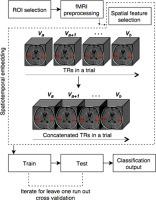Journal of Neuroscience Methods ( IF 2.7 ) Pub Date : 2020-07-26 , DOI: 10.1016/j.jneumeth.2020.108836 Jeiran Choupan 1 , Pamela K Douglas 2 , Yaniv Gal 3 , Mark S Cohen 4 , David C Reutens 5 , Zhengyi Yang 6

|
Background
In fMRI decoding, temporal embedding of brain spatial features allows the incorporation of brain activity dynamics into the multivariate pattern classification process, and provides enriched information about stimulus-specific response patterns and potentially improved prediction accuracy.
New method
This study investigates the possibility of enhancing the classification performance by exploring temporal embedding, to identify the optimum combination of the spatiotemporal features based on their classification performance. We investigated the importance of spatiotemporal feature selection using a slow event-related design adapted from the classic Haxby study. Data were collected using a multiband fMRI sequence with temporal resolution of 0.568 s.
Comparison with existing methods
A wide range of spatiotemporal observations were created as various combinations of spatiotemporal features. Using both random forest, and support vector machine classifiers, prediction accuracies for these combinations were then compared with the single spatial multivariate pattern approach that uses only a single temporal observation.
Results
Our findings showed that on average spatiotemporal feature selection improved prediction accuracy. Moreover, the random forest algorithm outperformed the support vector machine and benefitted from temporal information to a greater extent.
Conclusions
As expected, the most influential temporal durations were found to be around the peak of the hemodynamic response function, a few seconds after the stimuli onset until ∼4 s after the peak of the hemodynamic response function. The superiority of spatiotemporal feature selection over single time-point spatial approaches invites future work to design optimal approaches that incorporate spatiotemporal dependencies into feature selection for decoding.
中文翻译:

时间嵌入和时空特征选择提高了多体素模式分析解码的准确性。
背景
在 fMRI 解码中,大脑空间特征的时间嵌入允许将大脑活动动力学纳入多变量模式分类过程,并提供有关特定刺激反应模式的丰富信息,并可能提高预测准确性。
新方法
本研究探讨了通过探索时间嵌入来提高分类性能的可能性,以根据其分类性能确定时空特征的最佳组合。我们使用改编自经典 Haxby 研究的慢速事件相关设计来研究时空特征选择的重要性。使用时间分辨率为 0.568 秒的多波段 fMRI 序列收集数据。
与现有方法的比较
广泛的时空观察被创建为时空特征的各种组合。使用随机森林和支持向量机分类器,然后将这些组合的预测准确性与仅使用单个时间观察的单一空间多元模式方法进行比较。
结果
我们的研究结果表明,平均而言,时空特征选择提高了预测准确性。此外,随机森林算法优于支持向量机,更大程度上受益于时间信息。
结论
正如预期的那样,发现最有影响力的时间持续时间在血液动力学响应函数的峰值附近,刺激开始后几秒,直到血液动力学响应函数峰值后约 4 秒。时空特征选择相对于单一时间点空间方法的优越性需要未来的工作来设计将时空依赖性纳入解码特征选择的最佳方法。











































 京公网安备 11010802027423号
京公网安备 11010802027423号